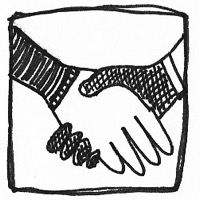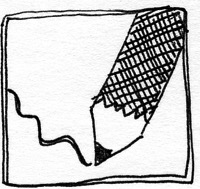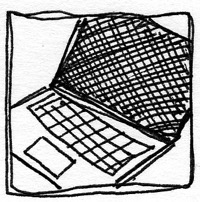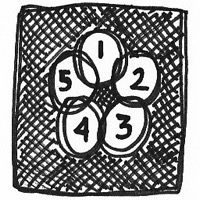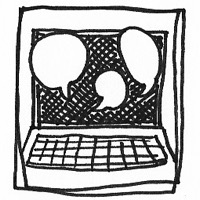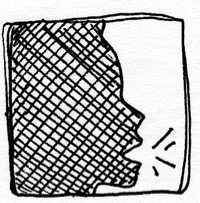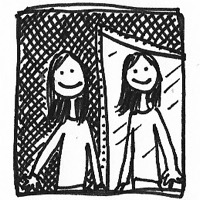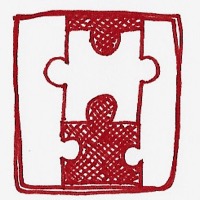Despite the nuance of some students' syntheses, which tied together key concepts in our eTC curriculum (Memory, reflection, community), many students retained a tendency to remain stuck in surface-level or regurgitative modes of thought, as some segments of the discussion board video we shared demonstrate. But, as we stressed in the Portfolio video shared on the Metacognitive Synthesis page, there are a few areas in which individual students were able to go deeper. We'll list here a few examples as we conclude to indicate habitual regurgitation as well as the kind of "deeper" and perhaps more perceptive integrative/community-focused engagement with Memory we're hoping to foster through our course design.
Certainly, some student remarks reveal the persistence of basic concepts of Memory:
- Some students see Memory as simply remembering things.
- Some spoke of just remembering items or ideas from their own pasts, and then using those to drive their research (so, the idea of Memory was overly literal, unconnected to writing/composing, so they did not make the "meta" move to other modes).
- Some students wrote/talked about memorizing the outcomes, which is different than integrating the sense and purpose of Memory (this is a very literal and itemized move).
- Some students discussed remembering information from one paper to use on another (this shows itemization; it is not a use of Memory but rather memory of things instead of application of lessons learned to future projects).
What encourages us in this research is that some remarks indicated reflective and integrated understandings of Memory, of Memory as symbolic (akin to the semiotic multivalence of the images that have helped you to navigate this webtext). Specifically, we are encouraged by the complex ways in which the discussion prompt moved students toward community-creation; many students cited one another, revealing an integration of others' knowledge as a constitutive component of one's own. Also, some students interpreted Memory as more about the ability to reflect, and they spoke of being able to create/apply new knowledge based on that reflection. Some students emphasized reflection leading to a future ability to analyze, so the mode of Memory as reflection is creating an ability to see previously learned knowledge and skills in more useful, integrated, multidimensional (even multimodal) ways later. Interestingly, one student noted the risk of Memory, in terms of bias (we were pleased to see an awareness of pros and cons from a student). Finally, students saw Memory as integral to the purpose of education; it allowed skills and reflections to scaffold, thus creating more purpose (as opposed to monotony or generic drill/kill approaches to education).
The multimodal application of students' situatedness within 21st-century communities is what we hope to stress in our work with them. In light of our objective to support community-building in the online technical communication classroom, we want our pedagogical design to reinforce to students the fact that most communities now rely on some multimodal means of communication, which they certainly know. Our goal is to help them develop the interpretive and practical skills required to lead in these communities as thoughtful integrators of multiple communication modalities, designed conscientiously to connect to multiple populations of co-workers, local community neighbors, and remote social network members.
As we unite at this webtext's close the main themes of our student learning outcomes, online technical communication pedagogy, and the relationship between these and the rhetorical canons as used in our curriculum, some might wonder, well, why the focus on Memory throughout our course and in this study? What do students gain—specifically—through a curricular deployment of this rhetorical concept, relative to metacognition as enabled by the multimodal pedagogy of a 16-week online class? As we've pointed out here, our integration of multimodal reflective discussion board opportunities for students gave them experience responding to a concept they previously (typically) considered unidimensionally, in that Memory to students signaled remembering and was not connected to the distinctive and complex temporalities of learning: a complex web of past, present, and future learning scenarios that emerge through various engagements, with other students, with members of one's work and social communities, and in written, audial, visual, and other modalities. A concentration on the rhetorical canon of Memory allowed us to frame technical writing instruction in such a way that students ultimately worked and played with multiple concepts related to our learning outcomes—and they worked and played with others in community-constitutive interactions, learning with and from each other.
The notions of "work" and "play" are apt to close with. They align with students' perceptions of coursework, that it is decidedly more like work, because they are obligated to perform tasks to receive a grade, than it is like play. But, as the Memory Game iconography used navigationally throughout this article, most prominently on our landing and overview pages, suggests, what at times seems simple (and, yes, the Memory game has been historically marketed to children as a way to sharpen spatial memorization through play) is often available to more nuanced and capacity-building engagement. Pedagogical incorporations of Memory—specifically, students grappling multimodally with this concept through classroom-community interactions—allow us to unlock the transformative and expanded capacity of concepts we all thought we knew: Memory, work, play, community, and communication.
Acknowledgements
We would like to thank the audience members of our panel "Multimodality as Advocacy: How Today's Communicators Create and Enter 21st Century Communities" at the 2016 ATTW annual meeting in Houston, Texas, for their valuable feedback on an early version of this project. We would also like to thank our copanelist from this presentation, Andrew Bourelle. Thanks go to Doug Eyman for his valuable insights on the development of the webtext for this study. Chuck Paine deserves commendation for his insights on deepening aspects of this project that connect theory to sample student work, particularly as it concerns reflection.
The HTML for this webtext was hand-coded by Julianne Newmark and all illustrations are her original work.
References
Ball, Cheryl E. (2012). Assessing scholarly multimedia: A rhetorical genre studies approach. Technical Communication Quarterly, 21(1), 61–77. https://doi.org/10.1080/10572252.2012.626390
Ball, Cheryl E., & Charlton, Colin. (2015). All writing is multimodal. In Linda Adler-Kassner & Elizabeth Wardle (Eds.), Naming what we know: Threshold concepts of writing studies (pp. 42–43). University Press of Colorado.
Borodkin, Yevgen. (2016). Rhetoric in technical communication: Europe and the United States. In Pavel Zemliansky & Kirk St.Amant (Eds.), Rethinking post-Communist rhetoric: Perspectives on rhetoric, writing, and professional communication in post-Soviet spaces (pp. 83–95). Lexington Books.
Bourdieu, Pierre. (1986). The forms of capital (Richard Nice, Trans.). In John Richardson (Ed.), Handbook of theory and research for the sociology of education (pp. 241–258). Greenwood.
Borup, Jered, Graham, Charles R., & Velasquez, Andrea. (2011). The use of asynchronous video communication to improve instructor immediacy and social presence in a blended learning environment. In Andrew Kitchenham (Ed.), Blended learning across disciplines: Models for implementation (pp. 38–57). IGI Global. https://doi.org/10.4018/978-1-60960-479-0.ch003
Borup, Jered, West, Richard. E., & Graham, Charles R. (2012). Improving online social presence through asynchronous video. The Internet and Higher Education, 15(3), 195–203. https://doi.org/10.1016/j.iheduc.2011.11.001
Bourelle, Andrew, Bourelle, Tiffany, & Jones, Natasha. (2015). Multimodality in the technical communication classroom: Viewing classical rhetoric through a 21st century lens. Technical Communication Quarterly, 24(4), 306–327. https://doi.org/10.1080/10572252.2015.1078847
Brooke, Collin Gifford. (2000). Forgetting to be (post)human: Media and memory in a kairotic age. JAC, 20(4), 775–795.
Brooke, Collin Gifford. (2009). Lingua fracta: Toward a rhetoric of new media. Hampton Press.
Brumberger, Eva R. (2007). Making the strange familiar: A pedagogical exploration of visual thinking. Journal of Business and Technical Communication, 21(4), 376–401. https://doi.org/10.1177/1050651907304021
Brumberger, Eva R. & Northcut, Kathryn (2013). Designing texts: Teaching visual communication. Routledge.
Cargile Cook, Kelli. (2002). Layered literacies: A theoretical frame for technical communication pedagogy. Technical Communication Quarterly, 11(1), 5–29. https://doi.org/10.1207/s15427625tcq1101_1
Cargile Cook, Kelli, & Grant-Davie, Keith (Eds.). (2005). Online education: Global questions, local answers. Baywood.
Carliner, Saul. (2010). Computers and technical communication in the 21st century. In Rachel Spilka (Ed.), Digital literacy for technical communication: 21st century theory and practice (pp. 21–50). Routledge.
Cobb, Susan. C. (2009). Social presence and online learning: A current view from a research perspective. Journal of Interactive Online Learning, 8(3), 241–254. https://doi.org/10.1207/s15427625tcq1101_1
Crowley, Sharon C. (1993). Modern rhetoric and delivery. In John Frederick Reynolds (Ed.), Rhetorical memory and delivery: Classical concepts for contemporary composition and communication (pp. 31–44). Routledge.
Davis, Anne, & McGrail, Ewa. (2009). "Proof-revising" with podcasting: Keeping readers in mind as students listen to and rethink their writing. The Reading Teacher, 62(6), 522–529. https://doi.org/10.1598/RT.62.6.6
Ewing, Laura A. (2013) Rhetorically analyzing online composition spaces. Pedagogy, 13(3), 554–561.
Garrison, Randy D. (2003). Cognitive presence for effective asynchronous online learning: The role of reflective inquiry, self-direction and metacognition. In John Bourne & Janet C. Moore (Eds.), Elements of quality online education: Practice and direction (pp. 47–58). The Sloan Consortium.
Garrison, Randy D., Anderson, Terry, & Archer, Walter. (1999). Critical inquiry in a text-based environment: Computer conferencing in higher education. The Internet and Higher Education, 2(2–3), 87–105. https://doi.org/10.1016/S1096-7516(00)00016-6
Gossett, Katherine. (2008). From manuscript to multimedia: Illuminating memory and re[image]ning composition [Unpublished doctoral dissertation]. University of Illinois at Urbana–Champaign.
Hewett, Beth L., & Bourelle, Tiffany. (2017). Online teaching and learning in technical communication: Continuing the conversation. Technical Communication Quarterly, 26(3), 217–222. https://doi.org/10.1080/10572252.2017.1339531
Hewett, Beth L., Bourelle, Tiffany, & Warnock, Scott. (2021). Teaching writing in the twenty-first century. Modern Language Association.
Holmes, Steve. (2017). The rhetoric of videogames as embodied practice: Procedural habits. Routledge. https://doi.org/10.4324/9780203731260
Johnson-Sheehan, Richard. (2012). Technical communication today (4th ed.). Pearson.
Katz, Susan M., & Odell, Lee (Eds.). (2012). Making the implicit explicit in assessing multimodal composition [Special issue]. Technical Communication Quarterly, 21(1).
Kress, Gunther. (2003). Literacy in the new media age. Psychology Press.
Kress, Gunther, & Van Leeuwen, Theo. (2001). Multimodal discourse: The modes and media of contemporary communication. Cappelen.
Lauer, Claire. (2013). Examining the effect of reflective assessment on the quality of visual design assignments in the technical writing classroom. Technical Communication Quarterly, 22(2), 172–190. https://doi.org/10.1080/10572252.2013.757156
Lynch, Maggie McVay. (2004). Learning online: A guide to success in the virtual classroom. Routledge. https://doi.org/10.4324/9780203353455
Manion, Christopher E., & Selfe, Richard "Dickie." (2012). Sharing an assessment ecology: Digital media, wikis, and the social work of knowledge. Technical Communication Quarterly, 21(1), 25–45. https://doi.org/10.1080/10572252.2012.626756
Mayer, Richard E., & Moreno, Roxana. (2003). Nine ways to reduce cognitive load in multimedia learning. Educational Psychologist, 38(1), 43–52. https://doi.org/10.1207/S15326985EP3801_6
Merriam, Sharan B., & Caffarella, Rosemary S. (1991). Learning in adulthood: A comprehensive guide. Jossey-Bass.
Miller, Carolyn. R. (1979). A humanistic rationale for technical writing. College English, 40(6), 610–617. https://doi.org/10.2307/375964
Porter, James E. (2009). Recovering delivery for digital rhetoric. Computers and Composition, 26(4), 207–224. https://doi.org/10.1016/j.compcom.2009.09.004
Rankins-Robertson, Sherry, Bourelle, Tiffany, Bourelle, Andrew, & Fisher, David. (2014). Multimodal instruction: Pedagogy and practice for enhancing multimodal composition online. Kairos: A Journal of Rhetoric, Technology, and Pedagogy, 19(1). https://kairos.technorhetoric.net/19.1/praxis/robertson-et-al/index.html
Shipka, Jody. (2011). Toward a composition made whole. University of Pittsburgh Press.
Stewart, Mary K. (2019). The community of inquiry survey: An assessment instrument for online writing courses. Computers and Composition, 52, 37–52. https://doi.org/10.1016/j.compcom.2019.01.001
Thomas, Angela. (2008). Community, culture, and citizenship in cyberspace. In Julie Coiro, Michelle Knobel, Colin Lankshear, & Donald J. Leu (Eds.), Handbook of research on new literacies (pp. 671–697). Lawrence Erlbaum Associates.
Thompson, Riki, & Lee, Meredith J. (2012). Talking with students through screencasting: Experimentations with video feedback to improve student learning. The Journal of Interactive Technology and Pedagogy, 1(1). https://jitp.commons.gc.cuny.edu/talking-with-students-through-screencasting-experimentations-with-video-feedback-to-improve-student-learning/
Welch, Kathleen E. (1999). Electric rhetoric: Classical rhetoric, oralism and a new literacy. MIT Press.
Whittemore, Stewart. (2015). Rhetorical memory: A study of technical communication and information management. University of Chicago Press.
Yancey, Kathleen Blake. (2004). Made not only in words: Composition in a new key. College Composition and Communication, 56(2), 297–328. https://doi.org/10.2307/4140651
Yancey, Kathleen, Robertson, Liane, & Taczak, Kara. (2014). Writing across contexts: Transfer, composition, and sites of writing. University Press of Colorado.
